4 Tips to Strengthen Workplace Culture, Safety
03
February,
2023
2 MINUTE READ

Inside a bucket lift, a new lineman was working nervously near a utility pole. From below, his supervisor began yelling. One wrong move and a hazardous situation can turn deadly, and by adding unnecessary pressure, such as in the example above, supervisors can wind up making things worse. This ultimately affects the entire workplace culture, in which the attitude of each worker contributes. There are ways to improve that culture for better efficiency and safety.
Proper Conduct
These days, shouting and poor behavior is less tolerated. A study by the Workplace Bullying Institute shows that 35% of American workers say they have experienced "repeated mistreatment" at work and 72% of those incidents came from their bosses. When a boss yells, workers can become more stressed. This type of leadership discourages workers, prevents communication, and produces a hostile work environment.
"Hearing, observing, or being the target of yelling in the workplace can be emotionally draining and can make it difficult to be productive so that you can meet your daily work expectations," writes Anne Kinsey, a business management professional in North Carolina.
How workplace leaders act can have a great impact on workers and safety culture. Good interpersonal skills help build trust, cooperation, respect, and create solid employee retention.
"There's a very big difference between managing and leading," said Michelle Ray, a workplace motivational speaker in Canada. Ray says top-level management on down needs to see managing beyond a transaction and make it more motivational. "Be a transformational leader with the vision to rise above challenges."
 When workplace leadership strengthens its commitment to safety, that action spurs better safety attitudes in others, which contributes to the workplace culture. A better workplace culture helps prevent workplace injuries. Here are several ways to improve the safety culture:
When workplace leadership strengthens its commitment to safety, that action spurs better safety attitudes in others, which contributes to the workplace culture. A better workplace culture helps prevent workplace injuries. Here are several ways to improve the safety culture:
- Accountability and ownership: Own up to behavior and set examples. Avoid jumping to blame and conflict. Challenge everyone to continually improve personal safety attitudes, with accountability to themselves, their customers, the organization, and the community.
- Behavioral changes: Improve competency, learn more, and erase entitlement attitudes. Don't yell or raise your voice. Instead, lead by example, with initiative. Go beyond the minimum effort. Calmly talk with employees privately when necessary.
- Communication: Set clear expectations and make safety a priority. Stop, open dialogue, and listen. You cannot expect your workers to be engaged when their workplace is not engaging. Improve stress reduction.
- Safety training tools: make sure everyone has what they need to do their work safety, from tools to resources to continuous education. Reinforce safety through toolbox talks, signs, and labels.
Continuous Improvement
Is everyone in the workplace doing what it takes to stay safe? An effective workplace safety culture uses accountability, behavioral changes, communication, and safety training tools. Building a better workplace culture and maintaining it is part of continuous improvement. This in turn helps to drive business growth, which is among many benefits of building a company culture around safety.
Get a reference guide to individual safety-related programs, regulatory requirements, and more in our free EHS Managers Guide.
RELATED RESOURCES

Strengthen Dust Collection System Safety
To work with dust, it must be controlled. Keep dust collection systems in top working order as well. ...
Read
Is Safety the Key to Operational Success?
We talk with EHS pros about how they started in safety management, the importance of their role, and how ...
Read
Crucial Objectives for Industrial Professionals
Workplaces are adjusting goals and protocols to meet new and changing demands. Here are a few key objectives ...
Read.png)


